Description and rules for keeping room milkweed
Euphorbia (euphorbia) belongs to the Euphorbia family. The succulent was named after the Moorish physician Euphorba. In apartment conditions, only some decorative varieties are grown. Consider what types are suitable for home maintenance and how to properly care for them.
- general description
- Varieties
- Mile
- Belozhilkovy
- Bighorn
- Armored
- Fairest
- Jellyfish head
- Cypress
- Brilliant
- Tree-like
- Variegated
- Sheflera
- Akrurensis
- Lactea cristata
- Platiklad
- Globular
- Bristled
- Lactic
- Papillary
- Melon-like
- Fatty
- Multi-prickled
- Pallas (Fischer)
- Purchase and adaptation
- Landing
- Growing conditions
- Choice of soil and location
- Humidity
- Lighting
- Temperature
- Care
- Fertilizers
- Watering
- Pruning
- Transfer
- Reproduction methods
- Cuttings
- Seeds
- By dividing the rhizome
- Diseases and pests
- Beneficial features
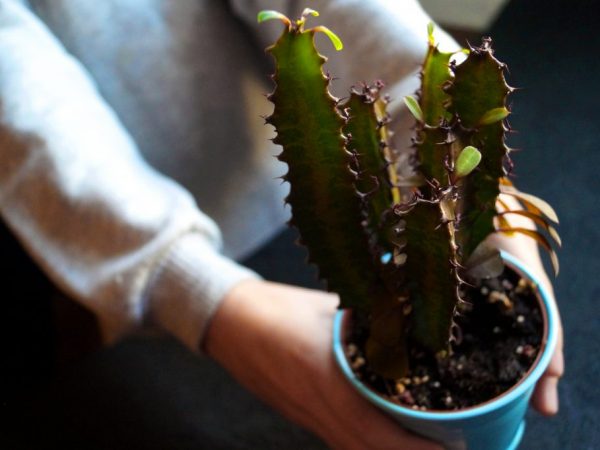
Description and rules for keeping room milkweed
general description
An ornamental leafy plant is readily used for landscaping residential premises and offices.
External parameters:
- depending on the variety, the height varies from 30 to 100 cm;
- stems are thin or thick, fleshy, sometimes covered with thorns;
- at the top or along the entire length there are green, juicy leaves of various sizes with a smooth surface;
- some species have bare shoots;
- the root system is branched, fibrous;
- flowering at home is rare.
As folk signs and superstitions say, euphorbia without thorns brings good luck, prosperity and prosperity to the house. T
You should not keep a thorny plant for those families who do not have mutual understanding and harmony in relationships, otherwise it will further aggravate the situation.
Varieties
Having familiarized yourself with the detailed name of the types of indoor flower, you can choose the most suitable variety for decorating your home interior.
Mile
Perennial succulent with good branching. The stem is ribbed, with a grayish tint. The leaves are elongated, green, 10-15 cm long, on the surface there are white, transverse stripes.
Bracts are reddish, orange or yellowish. Inflorescences of red or fiery color, collected in bunches.
Belozhilkovy
The plant in the form of a columnar perennial in appearance resembles a palm tree. The stem is fleshy, ribbed with oval leaves, pointed at the tips. The leaves are arranged on long petioles.
It blooms with inconspicuous small inflorescences, after flowering seeds are formed.
Bighorn
Perennial shrub succulent. The trunk in the lower part is zigzag, contains several erect shoots, arranged in a tier.
Spines grow on the edges of the ribs, they are gray or yellow-brown.
Armored
This subspecies, like other varieties of indoor milkweed, secretes poisonous milky juice. Stems are tetrahedral, forming long, thin leaves at right angles at the edges.
The length of the leaf plate in adult plants is 5-6 cm. The leaves develop in bundles, several pieces each.
Fairest
This is a deciduous variety - a small bracts of yellow, pink, white or red forms at the tips of each shoot.
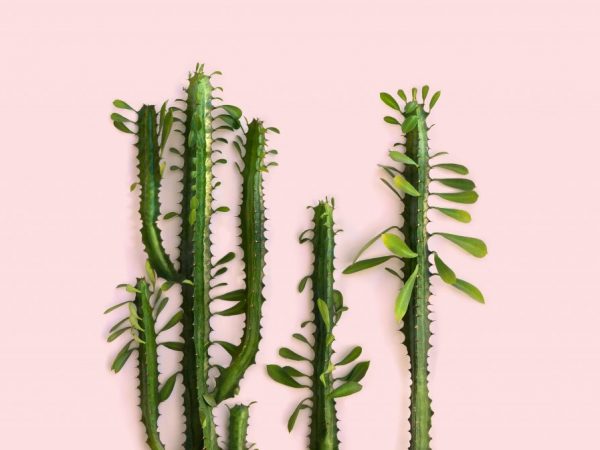
There are many varieties of milkweed
It blooms with inconspicuous small flowers of a yellowish-green hue. The flowering period is about 1.5 months.
Jellyfish head
The stem of this variety is underground, a large number of long, cylindrical shoots, reminiscent of the tentacles of a jellyfish, develop on the surface.
It blooms with small inflorescences of a yellowish tone, which are of no decorative value.
Cypress
A compact, small herbaceous plant 25-30 cm high. The stem is erect, grayish-green, glabrous, sometimes slightly pubescent. Leaves are oval, emerald, with a smooth surface.
The root system is creeping, cylindrical in shape. It blooms in May and fades in July, blooming in autumn is rare.
Brilliant
A beautiful spurge with erect, lignified shoots covered with dark brown bark. The surface contains thorns of the same tone as the bark.
During the growing season, the plant is strewn with green leaves of an oval or round shape. They are located along the entire length of the stems.
Tree-like
This species looks like a palm tree - a thick, fleshy, pentahedral stem at the top forms an elongated leaf shape. The trunk is erect, sometimes spiral. Emerald leaf plate, length 10-15 cm, width 4-5 cm.
On the underside of the leaves in the center there is a pronounced burgundy stripe.
Variegated
Perennial motley spurge is often confused with the Altai variety. This euphorbia is grown both as a garden and indoor crop. Stems are thin, light green, slightly leafy.
Leaflets are lanceolate with a pointed tip, 3-4 cm long, 2-3 cm wide.
At the top of the shoots of variegated milkweed, light green, dense inflorescences consisting of many petals are formed, closer to the center they acquire a yellowish tone. This combination of different shades gives the plant variegation.
Sheflera
The homeland of growth is Africa, Southeast Asia and South America. The flower of the Araliev family belongs to decorative deciduous plants with finger-dissected leaves.
The color of the leaf plate is monochromatic emerald or variegated, depending on the variety.
Euphorbia has a massive erect stem, covered along its entire length with leaflets located on elongated petioles.
Akrurensis
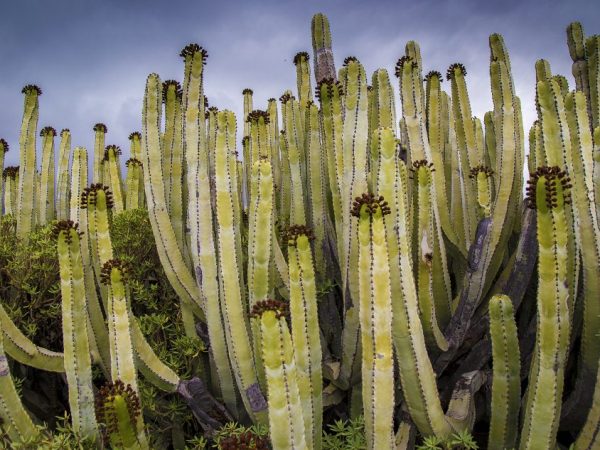
Euphorbia is poisonous
Another popular species among flower growers, which is called a cowboy cactus, a tree candelabrum. The homeland of growth is Africa and the East Indies.
This is a poisonous prickly plant - when broken, it secretes milky juice, if it gets on the skin and mucous membranes, it can cause allergies.
Description of the variety:
- the stem is massive, thick, consists of several faces;
- in adulthood, the flower forms lateral processes that repeat the shape of the main trunk;
- height varies from 50 to 80 cm;
- short brown spines develop on the edges.
Lactea cristata
The homeland of growth is the tropical zone of Asia. In the wild, it is a large-sized euphorbia with massive shoots; in culture, they have the shape of a rounded ridge or fan.
The stems are uneven with outgrowths, teeth and spines along the edges. The color is unusual - the main tone is dark green with a whitish center and pink edging. Some varieties contain a silvery sheen.
In summer, it can bloom - small flowers bloom along the edges of the ridges.
Platiklad
The second name is flat-stemmed. Forms long twisting emerald-colored shoots that grow in different directions. Small light brown thorns develop along the edges of the branches.
In adulthood, forms flower buds at the top of the stems. Inflorescences are small, pinkish or white, of no value.
The color of the shoots of the old spiny milkweed changes to dark brown.
Globular

Euphorbia can have a bizarre shape
Outwardly it resembles a cactus. Maximum height 7-8 cm, composed of numerous thick, barrel-shaped shoots. The surface is multifaceted, covered with short spines. The color of the stems is light green, the circumference can reach 50 cm.
The plant got this name thanks to the spherical shoots.
At the top, small leaves of an emerald tone can form, which after a while crumble.
Bristled
The second name is coarse-toothed. In the natural environment, it can reach gigantic proportions - up to 16 m in height, in cultivated form - up to 1 m.
This tree-like plant is similar to a cactus - with ribbed, triangular shoots, about 1.5 m in diameter. Spines 6 mm long develop along the edge of the ribs. Stems are covered with scaly leaves
Lactic
It differs in a milky white color of the stems - each branch contains 2-3 ribs with whitish stripes, sometimes they are double.
Variegated euphorbia is readily used in landscaping residential premises and offices.
Papillary
A miniature fringed shrub up to 20 cm high, forms cylindrical branches with a diameter of 6-7 cm.On the surface there are spines of a grayish tone, 1 cm long.
In the flowering phase, it looks especially beautiful - small flowers of different shades are formed on the tops of the shoots.
Melon-like
It is also called a false cactus, because it is very similar to it in appearance. A dwarf plant up to 10 cm high with a massive, oval stem, consisting of 3-5 ribs.
The entire surface of the shoot is covered with numerous yellowish spines, 1-1.5 cm long.
Fatty
This variety reaches 12 cm in length and 8 cm in width. The surface is striped with a weakly pronounced ribbing, does not contain thorns, forms single inflorescences of white or pale pink color.
Multi-prickled
Another unique variety of short stature with numerous shoots, gray-green in color, the surface consists of 4-5 ribs, diameter 2.5 cm.
Spines up to 8 mm long grow on the stems. This spurge is dangerous for children and pets, with injections it can cause severe irritation, so keep it out of the reach.
Pallas (Fischer)
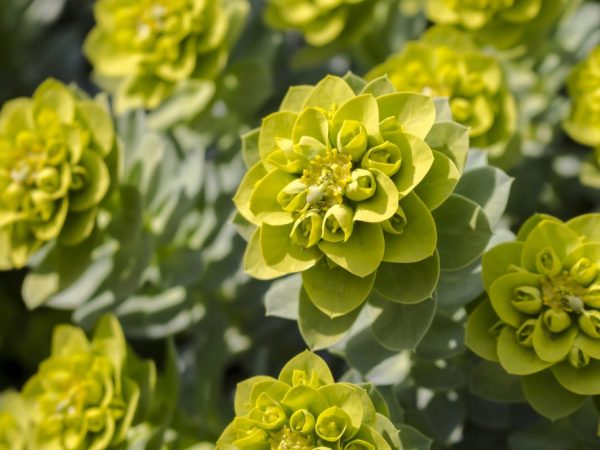
Pallas spurge has medicinal properties
The people call the decorative perennial a man-root. It has medicinal properties, since it contains lactones, which have an antibacterial and antitumor effect.
The root system is tuberous, massive, beige. The stems are thin, the leaves are small green.
Purchase and adaptation
You can buy all varieties of indoor milkweed in one of the flower shops.
When choosing, pay attention to the condition of the plant. In viable:
- the crown is fresh, juicy, rich in color in accordance with the description;
- stems and leaves do not contain yellow, black spots, blotches and growths;
- the substrate should be fresh, slightly damp, without acidification and mold on the surface.
The price for one seedling is from 250 to 700 rubles.
After the purchase, the spurge is kept separate from all vegetation for several weeks. During this time, he will have time to adapt to room conditions.
If after this period no infections and parasites are detected on it, you can safely place it among other flowers.
Landing
Almost all types of indoor milkweed have a superficial fibrous root system. Therefore, for planting, it is necessary to take a wide and not too deep container. Use a ceramic or plastic pot with drainage holes.
A little expanded clay or pebbles are poured, then up to half the volume of fertile soil. The roots are lowered, the soil is poured to the top, tamped, watered.
For tree and shrub forms, support is needed, therefore a special mini-trellis is installed next to the stem.
Growing conditions
Almost all types of euphorbia need the same care - regular hydration, fertilization, and periodic pruning.
Choice of soil and location
Euphorbia grows well in light, loose soil. Many people use store-bought composition for cacti and succulents.
Some growers prepare the soil mixture on their own, mixing leafy soil with humus and sand in a 2: 3: 2 ratio.
The second variant of the substrate is turf with sand in equal amounts.
The best place to contain would be the southwest or west side of the house, where there is continuous daylight and no direct scorching rays.
Monochrome varieties are placed on the windowsill on the east side. Variegated ones are especially demanding for light - due to its lack, the leaves turn pale and lose their original variegation.
Humidity
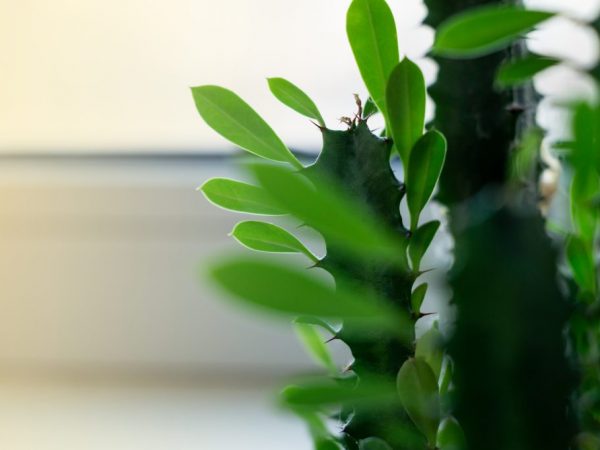
Warm water is suitable for spraying.
Indoor spurge is a drought-resistant crop, therefore it is not picky about moisture. The optimal indicator is 60-65%.
To support decorativeness and prevent the appearance of parasites, it is periodically sprayed on hot days - every three days.
In autumn and winter, to wash off the dirt from the leaves and stems, irrigate once a month. Use water at room temperature.
Lighting
This plant has a long light day - it needs at least 10 hours a day.
- In summer, flowers can be kept on the balcony, terrace, loggia with the possibility of shading from the scorching sun and protection from drafts.
- In the winter season, when kept on the north and east windows, artificial lighting with a fluorescent lamp will be required. The device is placed at a distance of 50-60 cm from the crown.
- It is recommended to keep variegated varieties in the southern corner of the house, because from a lack of light, their leaves acquire a solid green color.
Temperature
During the growing season (spring and summer), the optimum temperature is 18-25 ° C. In the winter season, it is lowered to 16 ° C, since the flower goes into a dormant period.
Some varieties thrive at 4-6 ° C all year round.
In autumn and winter, the room needs to be ventilated periodically. At this time, the spurge is moved to another room, since it can drop foliage and wither from sudden temperature changes.
Care
Fertilizers
All species of the Euphorbiaceae family should be fed during the period of active growth and development (spring and summer).
For decorative deciduous plants, special fertilizers are used for succulents and cacti. Feeding is introduced in liquid form once a month.
In the budding phase, flowering euphorbia is additionally fed with preparations containing potassium. In the autumn-winter period, food is completely stopped.
Watering
The main care for this flower includes regular moisture - as the soil dries up to a depth of 3-4 cm.
Euphorbia reacts poorly to overflows.
To avoid the development of root rot, it is worth using settled water at room temperature. The water accumulated in the pan is poured after watering.
After a day, the soil is loosened so that it remains light and moisture-permeable.
Pruning
Formation is required for bush varieties. Correction of the crown is carried out in winter - all shoots are cut out. After such a radical haircut, the plant will not bloom, but next year it will delight you with a large number of inflorescences.
Sanitary pruning is also necessary in the summer after flowering. Dry, yellowed, broken off stems with leaves should be removed. Also pruned shoots that are too elongated. In a flowering variety, young stalks are left, on which flowers will appear next year.
A sharp and sterile instrument is used to prevent infection with a viral, bacterial, or fungal infection.
Transfer

Purchased plants need to be transplanted
This procedure is necessary for purchased specimens, since store-bought soil is not suitable for further cultivation. You should definitely wait for the plant to bloom, and only after that it can be transplanted.
Take a flowerpot with holes at the bottom in diameter 2-3 cm larger than the previous container. Expanded clay is poured to the bottom, then a small layer of fertile composition.
The soil is watered abundantly, after an hour it is removed and, together with an earthen lump, is transferred into a new container. The soil is poured to the top, crushed around the stem, and moistened.
Home flowers need a transplant - usually this procedure is carried out every 2-3 years. You also need to transplant a specimen whose roots are rotten or damaged by infection, parasites.
Euphorbia is watered, removed from the flowerpot, washed off the remnants of the soil, cut out all the roots to healthy tissue, dipped in a fungicide solution. Dried, transplanted into a new container with a sterile substrate.
Reproduction methods
Cuttings
Vegetative propagation is considered one of the simplest and most effective. This procedure is started in the fall, when the plant completely discards the inflorescences.
The technology consists of several stages:
- cut off shoots 10 cm long at the top of the stem from under the leaf node;
- in the lower part of the shoot, pinch off all the leaves;
- immersed in water for an hour to wash off the remnants of milky juice;
- then removed, dried, powdered with charcoal;
- planted in moist coarse sand, watered, covered with foil.
Further care consists in periodic moistening, airing.
As soon as the cuttings release new leaves, the shelter is removed, they continue to grow for another month, after which they are transplanted into a pot.
Seeds
You can propagate a flower by the seed method. The collection of seeds is carried out in the fall, in order to avoid their self-seeding, each box is wrapped in a cloth in advance. Ripe seed can be stored in a paper bag for no more than a year. It is advisable to sow immediately after harvest.
Seedlings will require a seedling box or plastic container. It is filled with a mixture of peat and sand (1: 1). To avoid contamination, the soil is calcined in an oven or spilled with boiling water.
Before planting, the seeds are soaked in water for 24 hours, then spread wet on the surface of the substrate, sprinkled on top with a thin layer of the remaining soil mixture.
Cover with transparent glass or foil, put in a warm place with diffused daylight. Until the moment of germination, the crops are periodically irrigated from a spray bottle, ventilated every day.
As soon as greenery appears on the surface of the soil, the shelter is removed, and watering continues. At the stage of the appearance of one pair of leaves, the seedlings need to be planted in separate flowerpots.
By dividing the rhizome
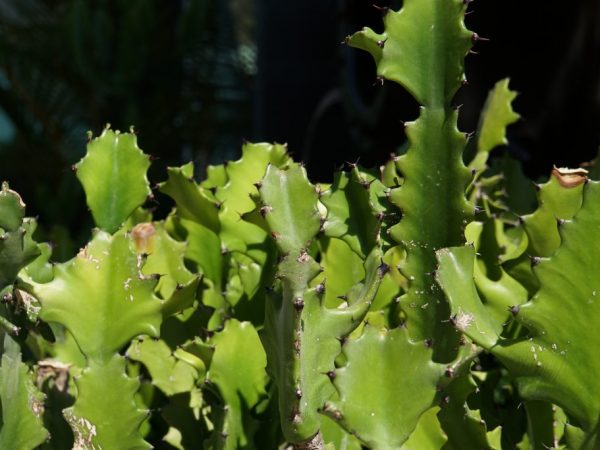
A transplant is required to rejuvenate the plant
Reproduction of indoor milkweed by this method is used during the rejuvenation of an old bush or when an adult plant is damaged by infection, parasites and needs a transplant.
It is watered abundantly, then removed from the flowerpot, the roots are washed, all rotten and moldy fragments are cut out, powdered with charcoal, dried. Divide the root system into parts so that each has one stem and several roots. Cut off places are sprayed with fungicide, dried. They are seated in separate pots.
Diseases and pests
Indoor euphorbia rarely gets sick, its poisonous milky juice repels many parasites. But if the rules of agricultural technology are violated, the flower's immunity weakens and it becomes vulnerable to various diseases.
| Diseases and pests | Signs | Treatment methods | Prophylaxis |
| Mealybug | You can determine the appearance of this parasite by the white sticky bloom on the surface of the stems and foliage. The lesions turn yellow, then turn brown and die off | In the fight against insects, a solution of laundry soap (40 per 1 liter of water) is used with the addition of a couple of drops of machine oil. From folk remedy helps infusion of garlic, calendula and tobacco | Use sterile soil for planting and transplanting, observe the irrigation regime and maintain humidity at the desired level |
| Shield | Round orange or red spots on the surface of leaves, shoots are a sure sign of the invasion of this pest. He feeds on their juice, leads to wilting and yellowing of all organs. Leaves fall massively | Decis will help get rid of the scabbard. Irrigation of the soil and crown is carried out twice with an interval of 7 days | Plant flowers in pre-disinfected soil, regularly inspect the crown and remove parasites with a cotton swab dipped in one of the fungicides |
| Thrips | Silvery or yellowish stripes on foliage are a sign of a pest. Damaged areas turn yellow, curl and dry out | Processing Aktara, Fitoverm | Buying healthy plants, using fresh and sterile soil for planting and replanting |
| Root rot | Frequent waterlogging with cold water, as a result, the root system and the central shoot rot. The trunk turns black, becomes slippery, soft, leaves fall | It is difficult to revive such a plant. Therefore, at the top, the stalk is separated and rooted | Adjust watering, use room temperature water |
Beneficial features
This plant has medicinal properties - its benefits are expressed in the ability to heal fungal skin diseases, eczema, warts, lichen.
The roots are used in the treatment of diseases of the gastrointestinal tract. Alcohol tincture of milkweed helps to get rid of cystitis and headaches.
A flower can also cause serious harm - milky juice is dangerous and has a poisonous effect on the body. Causes severe burns on the skin and mucous membranes. Therefore, you need to ensure that your child or pet does not accidentally eat the leaves or stems.

